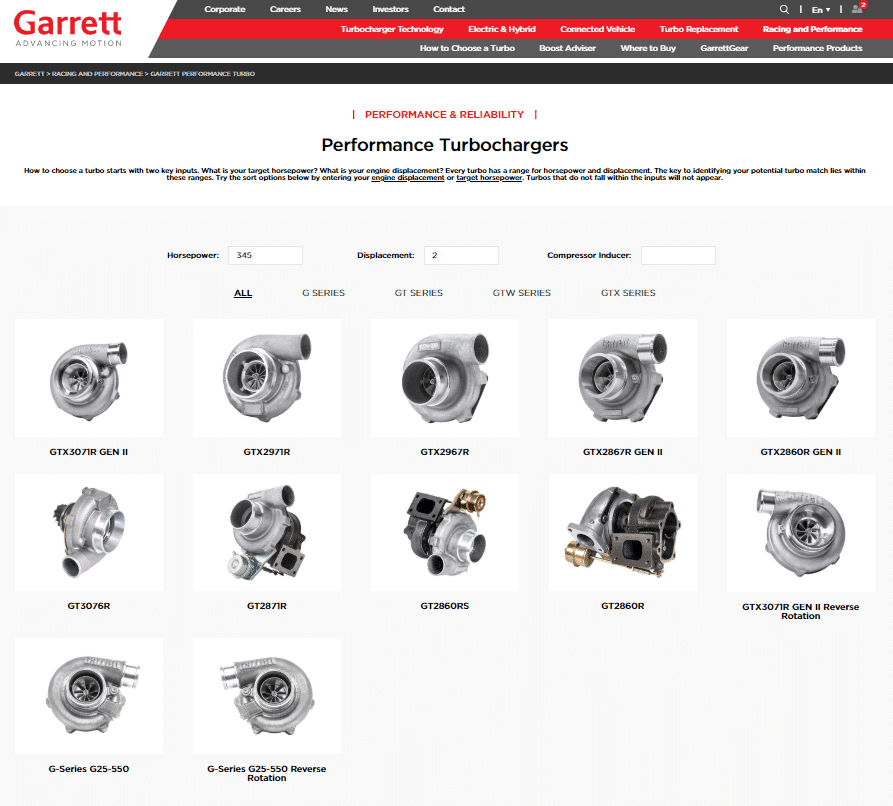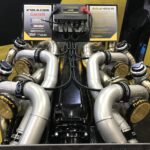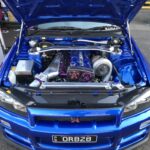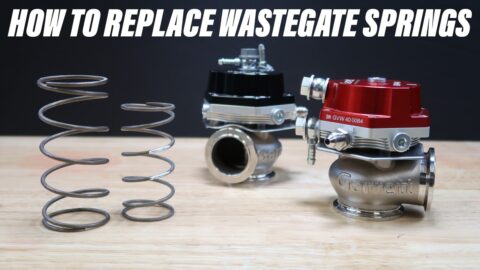Accessing the Knowledge Center effectively requires a simple, one-time registration.
How To Select A Turbo
Garrett Advancing Motion continues to engineer the most diverse range of engine boosting products and accessories for racing and performance enthusiasts. With over 35 different turbochargers to choose from, how do you know what’s best for your engine setup? This write up will cover the principles and basics of turbo matching. For advanced and expert tech click here. Garrett racing and performance turbos are capable of supporting an engine displacement range of 1.4L up to 12.0L engines and horsepower at the crank from 140 up to 3000 per turbocharger! Keep in mind that Garrett horsepower rating estimates are measured at the crank. Properly selecting the right size turbocharger for your application is critical in getting optimal results. If you select a turbo that’s too big for your application you will experience turbo lag. Inversely if the turbo is too small you risk not reaching your horsepower target, and increasing your risk of over speeding the turbo, which leads to turbo failure and possible costly engine damage. Don’t just get the big turbo because it looks cool. As our technology advances and our research continues, Garrett engineers continue to innovate the industry by creating more power at higher efficiency from smaller turbos.
Wheel Vs Crank Horsepower And Parasitic Loss
Target horsepower refers to the peak horsepower you want the car to make when it is at max engine RPM. At the crank. Horsepower at the crank is different than horsepower at the wheels due to parasitic loss. Also known as drivetrain loss, this refers to power lost by the engine from the time it travels through the transmission to the driveline, and through the axles to the wheels. Drivetrain loss is affected by transmission type (FWD, RWD, AWD) with the loss being higher in applications with automatic transmissions. You should estimate drivetrain loss before starting your project to avoid any confusion or disappointment when your car gets hits the dyno.
Tuner Tip From Mike Mcginnis- Innovative Tuning: Big brakes, heavy wheels and tires also affect drivetrain loss. Some dynos can perform a parasitic loss test/ coast down test so inquire with your tuner.
If you are searching for a wheel horsepower target you can use the following recommendations to calculate your target crank horsepower. (FYI, automakers rate a vehicle’s horsepower at the crank)
For this example we are going to start with a wheel horsepower target of 600 for a rear wheel drive application. In order to find a turbo that can support our target power we need to calculate for the drivetrain loss so we must multiply 600 * 1.15 = 690.
- Front Wheel Drive 10% (multiply HP target by 1.1) Wheel Horsepower * 1.1 = Crank Horsepower
- Rear Wheel Drive 15% (multiply HP target by 1.15) Wheel Horsepower * 1.15 = Crank Horsepower
- All-Wheel Drive 20% (multiply HP target by 1.2) Wheel Horsepower * 1.2 = Crank Horsepower
Now that we have 690 as our crank horsepower target we can use the Garrett Performance turbo feature to eliminate non-matches. Each turbocharger has an operating range measured by crank horsepower and engine displacement measured in liters. Once you have those two inputs defined you can use the performance turbo product page to sort your options. At the top of the product page you will see a box for horsepower and displacement in liters. Enter your HP and Disp inputs to find your basic matches. (In the example below we used 690 horsepower and 4.0 Liter Displacement)
There are still quite a few results. We counted 16 including the reverse rotation configurations of the GTX3582R Gen II, GTX3576R Gen II, and the G Series G35-900

Turbo results for a 600WHP target and 4.0L engine. Here we calculated the drivetrain loss for a RWD application so 600 x 1.15 = 690 crank horsepower.
Matching For Vehicle Application
Another important factor for proper turbo matching is vehicle application. An autocross car requires rapid boost response so a smaller turbo or smaller turbine housing would be suitable for this application. This will sacrifice max power at high RPM but boost response will be excellent. A drag car that is seeking max power and top end speed will likely select a larger turbo and large turbine housing in order to maximize air flow going into the turbine stage. These are the very basic steps for turbo matching but important factors to consider when narrowing your search for the right turbo.
Tuner Tip From Mike Mcginnis- Innovative Tuning: Matching a turbo for fuel type is also important. For example if a racer wants to make 500 whp on pump gas vs E85 I’d likely spec different turbos, oversizing the compressor to make the power on pump gas without high compressor outlet temps and to help reduce exhaust temps which helps with margin of safety to knock.
Matching For Single Turbo and Twin Turbo Applications
With target horsepower defined we need to figure out if we want a twin or single turbo setup. Both types can make the power efficiently and with great response. Sometimes engine space is a major factor and all you can do is fit two smaller turbos. Or maybe the manifold you have purchased only comes in a single turbo configuration. The decision is yours to analyze and make based mostly on budgets and availability of components. Here’s an additional calculation to consider for a twin turbo setup. If you have a 4 liter engine and you want to make 690 crank horsepower with twin turbochargers you need to divide your target horsepower and engine displacement by 2 and find a match based on the sum of half of the target inputs. Our example of a 4 liter engine and 690hp target power would now become a 2.0L and 345hp match.
Using the performance product page sorting feature, enter 345 and 2.0 and the new results will populate. The twin turbo results are much different than the products from the single turbo calculations. Keep in mind the results shown from these inputs are products that fall within the horsepower and displacement ranges of the Garrett Turbo product line. More research will need to be done to find a turbo match. This webpage feature is intended to give you a starting point for how select a turbo.

Matching for twin turbo applications requires dividing the target power goals and engine displacement by 2
Standard and Reverse Rotation Turbo Setups
Garrett offers turbochargers in standard and reverse rotation configurations. Sometimes referred to as mirrored or mirror image turbos, these options make it possible to create perfect symmetry to your turbo system. A reverse rotation compressor wheel spins in a counterclockwise rotation and features a left pointing compressor housing outlet. Remember, the compressor wheel rotation dictates the flow path of the air. Standard rotation turbochargers spin clockwise with a right pointing compressor outlet. The images below show several different engine configurations and turbo setups.
- Quad turbo V12 LS using two sets of GTX3582R Gen II mirrored turbochargers for this crazy build by Haltech
- Twin turbo standard rotation drag race setup for racer Mark Micke
- Mirrored image GTX3076R Gen II turbo system built by Jason Schmuck
- Single turbo G42 in a R34 GTR
Narrowing The Search Results
Now we can narrow down our turbo search from one of the examples above. For this we decided on a twin turbo application. Our next step requires us to look at each turbo product page and find out what turbine kit options are available, and to review the horsepower and displacement range of each turbo. A basic rule of thumb is if your engine horsepower and displacement targets (345 / 2.0L) are too close to the low or high range of the turbo the match is more likely to have poor efficiency and is not the best option. A good match gives you the power and response you need in an efficient part of the map and that tends to be closer to the middle of the ranges.
Remember, our requirements of the turbo are 345 horsepower for 2.0L because this is for a twin turbo application. Our total goal is to make 690 with a 4.0L engine.
GTX3071R Gen II: 340-650 Horsepower & 1.8L – 3.0L Displacement. The turbine housing inlet options are available in T3 and V-band inlet with V-band outlets. At first glance the target horsepower range (345) is only 5hp more than the low limit of the turbo (340). Your car doesn’t operate at full RPM all the time so this turbo will make even less power at lower engine RPMs. This turbo is not the best option and we will continue the search.
G Series G25-550: 300-550 horsepower and 1.4L- 3.0L displacement. The turbine housing inlet options are available in mostly V-band with one T25 option. Our horsepower needs are more within the turbo range. Displacement is also between the range. The G25-550 is offered in standard and reverse rotation for mirrored setups. This turbo is a much better match option than the GTX3071R Gen II.
Conclusion
These are the basic steps for turbo matching. You should now be able to identify and calculate your target crank horsepower target using the calculations for drivetrain loss. Once a single turbo or twin turbo configuration has been figured out you can calculate the proper inputs to enter into the performance product page turbo sorting feature to narrow your options. You also know what to look for when looking through each turbo page. This is just one tool that you can use to improve your knowledge of the turbocharger system. There are many more factors that need to be considered when selecting a turbocharger and you can read about them in part 2.
If turbo matching is still confusing there is another tool we developed that will do all the sorting for you based on your inputs. It’s called Boost Adviser. It’s free and you can click the image below to take you to it.
























